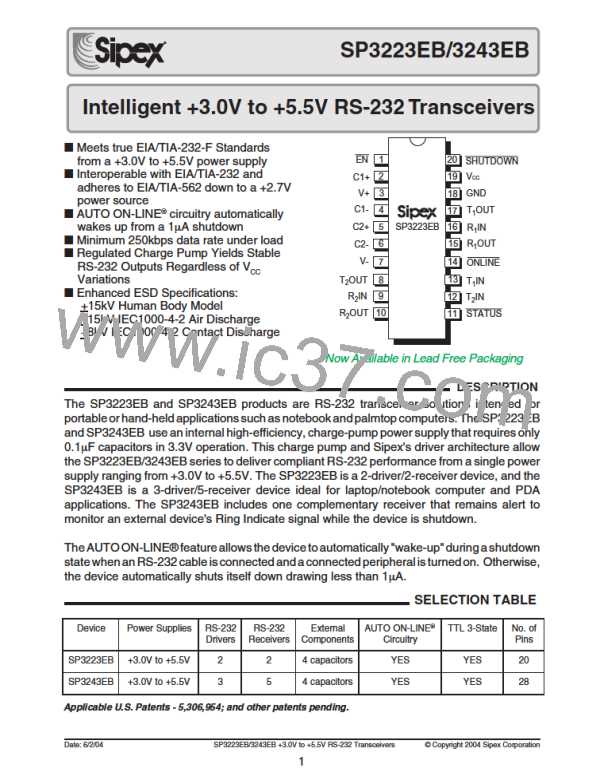normal usage. The transceiver IC receives most
of the ESD current when the ESD source is
applied to the connector pins. The test circuit for
IEC1000-4-2 is shown on Figure 31. There are
two methods within IEC1000-4-2, the Air
Discharge method and the Contact Discharge
method.
ESD TOLERANCE
The SP3223EB/3243EB series incorporates
ruggedized ESD cells on all driver output and
receiver input pins. The ESD structure is
improved over our previous family for more
rugged applications and environments sensitive
to electro-static discharges and associated
transients. The improved ESD tolerance is at
least +15kV without damage nor latch-up.
With the Air Discharge Method, an ESD voltage
is applied to the equipment under test (EUT)
throughair. Thissimulatesanelectricallycharged
person ready to connect a cable onto the rear of
the system only to find an unpleasant zap just
before the person touches the back panel. The
high energy potential on the person discharges
through an arcing path to the rear panel of the
system before he or she even touches the system.
This energy, whether discharged directly or
through air, is predominantly a function of the
discharge current rather than the discharge
voltage. Variables with an air discharge such as
approach speed of the object carrying the ESD
potential to the system and humidity will tend to
change the discharge current. For example, the
rise time of the discharge current varies with the
approach speed.
There are different methods of ESD testing
applied:
a) MIL-STD-883, Method 3015.7
b) IEC1000-4-2 Air-Discharge
c) IEC1000-4-2 Direct Contact
The Human Body Model has been the generally
acceptedESDtestingmethodforsemiconductors.
This method is also specified in MIL-STD-883,
Method 3015.7 for ESD testing. The premise of
this ESD test is to simulate the human body’s
potential to store electrostatic energy and
discharge it to an integrated circuit. The
simulation is performed by using a test model as
shown in Figure 30. This method will test the
IC’s capability to withstand an ESD transient
duringnormalhandlingsuchasinmanufacturing
areaswheretheICstendtobehandledfrequently.
The Contact Discharge Method applies the ESD
current directly to the EUT. This method was
devised to reduce the unpredictability of the
ESD arc. The discharge current rise time is
constant since the energy is directly transferred
without the air-gap arc. In situations such as
handheldsystems,theESDchargecanbedirectly
dischargedtotheequipmentfromapersonalready
holdingtheequipment. Thecurrentistransferred
ontothekeypadortheserialportoftheequipment
directly andthentravelsthroughthePCBandfinally
to the IC.
The IEC-1000-4-2, formerly IEC801-2, is
generallyusedfortestingESDonequipmentand
systems. For system manufacturers, they must
guarantee a certain amount of ESD protection
since the system itself is exposed to the outside
environment and human presence. The premise
with IEC1000-4-2 is that the system is required
to withstand an amount of static electricity when
ESD is applied to points and surfaces of the
equipmentthatareaccessibletopersonnelduring
R
R
S
S
R
R
C
C
SW2
SW2
SW1
SW1
Device
Under
Test
DC Power
Source
C
C
S
S
Figure 30. ESD Test Circuit for Human Body Model
Date: 6/2/04
SP3223EB/3243EB +3.0V to +5.5V RS-232 Transceivers
© Copyright 2004 Sipex Corporation
18

 SIPEX [ SIPEX CORPORATION ]
SIPEX [ SIPEX CORPORATION ]